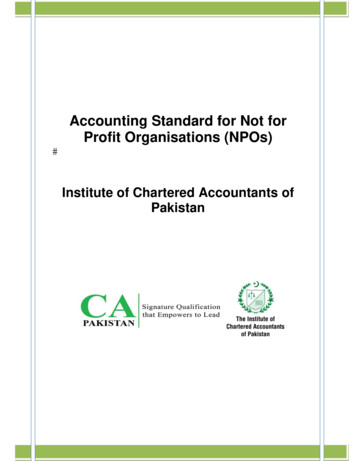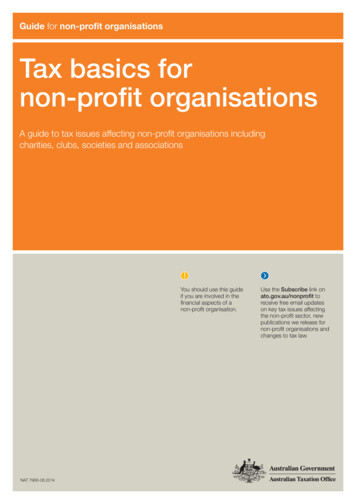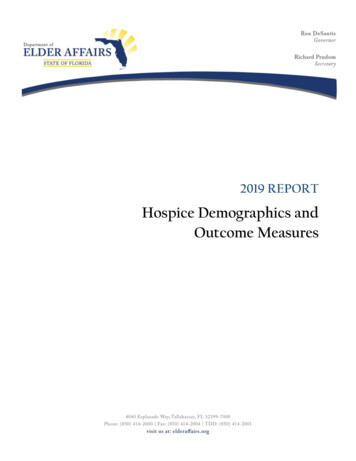
Transcription
AAccoountinng Sttandaard ffor Not foorProofit OrganOnisations (NPOOs) Institutte of Charrteredd Acccounttants ofPaanakista
Copyright 2015 The Chartered Professional Accountants of Canada(a) The Chartered Professional Accountants of Canada (CPA Canada) has acted solely asthe publisher of Part III: Accounting Standards for Not-for-Profit Organizations. CPACanada nor any committee thereof, has reviewed the Accounting Standards for Not forProfit Organizations (NPOs) as published by ICAP and therefore, have no responsibilityfor the contents of the Accounting Standards for Not for Profit Organizations (NPOs), northe use thereof; and;(b) Reprinted and adapted with permission from Part III: Accounting Standards for Not-forProfit Organizations, 2012, The Chartered Professional Accountants of Canada, Toronto,Canada. Any changes to the original material are the sole responsibility of the authorand/or publisher and have not been reviewed or endorsed by CPA Canada.
Accounting Standard for Not-for-Profit Organizations(NPOs)CONTENTSSection – 1 Introduction6Basis of AccountingPrimary SourcesConsistency of accounting policiesSection- 2 Financial Statements Concepts8Objective of Financial StatementsThe cost constraint on useful financial reportingQualitative tyReliabilitySubstance over e characteristics trade-offElements of Financial StatementsFinancial PositionAssetsLiabilitiesNet l BasisRecognition CriteriaMeasurementGoing Concern1
Section-3 General standards of financial statement presentation IAS 113Fair PresentationGoing ConcernFinancial StatementsComparative InformationDisclosureSection- 4 Financial Statements presentation15GeneralFund AccountingInter-fund transfers and balancesStatement of Financial PositionDisclosure of restrictionsDisclosure of restrictions — deferral methodDisclosure of restrictions — restricted fund methodStatement of Income and ExpenditureStatement of income and expenditure — deferral methodStatement of income and expenditure — restricted fund methodPresentation of revenues and expensesStatement of Changes in Net AssetsStatement of Cash FlowsIllustrative ExamplesReporting revenues and expenses gross versus netExample 1 — Funded developmentExample 2 — Direct fundraising activitiesExample 3 — Fund raising conducted by othersSection – 5 Inventories20GeneralRecognition and MeasurementContributions of materialsInventories to be distributed at no charge or for a nominal charge2
Section- 6 Contributions — Revenue Recognition21Restricted contributionsRestricted government funding — special considerationsRevenue RecognitionContributed materials and servicesMeasurementDisclosureDeferral MethodRecognition of endowment contributionsRecognition of restricted contributions for expenses of future periodsRecognition of restricted contributions for the purchase of capital assetsRecognition of restricted contributions for the repayment of debtRecognition of restricted contributions for expenses of the current periodRecognition of unrestricted contributionsRecognition of net investment incomePresentation and disclosureDeferred contributionsNet investment income earned on resources held for endowmentRestricted Fund MethodRecognition of endowment contributionsRecognition of restricted contributions reported in restricted fundsRecognition of restricted contributions reported in the general fundRecognition of unrestricted contributionsRecognition of net investment incomePresentation and disclosureDeferred contributionsNet investment income earned on resources held for endowmentSection- 7 Contributions Receivable28RecognitionPledges and bequestsDisclosure3
Section- 8 Property, Plant & Equipment29Recognition and MeasurementConstruction or development over timeLand and certain works of art and historical treasuresAmortization when a fund accounting basis of reporting is usedReview of depreciation and useful lifeTreatment of unamortised deferred contributionsPresentation and DisclosureContributed Property, Plant and EquipmentSection- 9 Intangible Assets31Recognition and MeasurementTreatment of unamortised deferred contributionsContribute intangible assetsSection – 10 Collections32Nature of CollectionsDisclosureSection – 11 Reporting Related Organizations33Economic interestRelationships with funding bodiesDisclosure of Economic InterestSection – 12 Disclosures of Related Parties Transactions34Identification of Related PartiesDisclosuresDescription of relationshipDescription of transactionAmount of transactionsMeasurement basisAmounts due to or from related partiesContractual obligations and contingencies4
Section- 13 Disclosure of Allocated Expenses36Attribution and allocation of expensesDisclosure of allocated expensesAttribution of expensesBases for attributionSection- 14 First time Adoption37Compliance ounting policiesContributionCostCollectionsDeferral methodDeemed costEndowment fundEndowment ContributionEconomic interestFair valueFund accountingGeneral fundintangible assetNet carrying amountNot-for-Profit organizationsOpening statement of financial positionRestrictionsRestricted contributionRestricted fundRestricted fund methodResidual valueRelated partiesRelated party transactionsService potentialSignificant influenceSubsequent depreciationTangible capital assetsUnrestricted contributionUseful life5
Accounting Standard for Not-for-Profit Organizations(NPOs)Section – 1 Introduction1.1Not-for-Profit Organization (NPO) include entities formed for promoting education, health, finance &commerce, art, science, religion, sports, social services, charity or any other useful object, and applies orintends to apply its profits, if any, or other income in promoting its objects, and prohibits the distribution ofsurplus to its members, sponsors, promoters, etc.Non Profit Organisations (NPOs) established for the purposes defined above, whether or not the enterprise isformed under Section 42 of the Companies Ordinance, 1984 and interalia include trusts formed under theTrust Act, 1889 or societies formed under the Societies Act or any other recognisable form of organisationgiving value to the groups of people they administer to.1.2. Not-for-Profit Organizations are divided into following classes:a) Large Sized Not-for-Profit Organizations, being organizations with annual gross revenue of morethan Rs.500 million.b) Medium Sized Not-for-Profit Organizations, being organizations with annual gross revenuesbetweenRs.100 million and Rs.500 million.c) Small Sized Not-for-Profit Organizations, being organizations not falling in a) or b) or d).d) Micro NPOs, being organizations not registered under Companies Ordinance, 1984 with annualgross revenue less than Rs.25 million.Scope1.3 This standard is applicable to the Not-for-Profit organizations registered under The Companies Ordinance,1984.1.4A Not-for-Profit organization, not registered under The Companies Ordinance, 1984, is recommended toprepare its financial statements in accordance with this standard and shall state that its financial statementshave been prepared in accordance with ‘Accounting Standard for NPOs’.Basis of Accounting1.5.A Not-for-Profit organization that is registered under the Companies Ordinance, 1984, is required to prepareits financial statements in accordance the Fifth schedule of the Companies Ordinance, 1984 . Theseorganizations will apply provisions of this Standard so far as they are not in conflict with the provisionscontained in the Companies Ordinance.1.6.The main text of the Standard deals with the normal accounting practice for NPOs that produce full accrualbased accounts. Some NPOs will have to meet additional requirements while others may have the option ofpreparing briefer reports and accounts. Micro NPOs are encouraged to use accrual based accounting using aspecified framework i.e. AFRS for SSEs. Alternately, these Micro NPOs may use the method described in 1.9(d).1.7.A NPO classified as a Public Interest Entity (PIE) will in addition to this Standard will prepare its financialstatements under IFRS as applicable in Pakistan.Primary Sources1.8.A Not-for-Profit organization applying this Standard will also apply the primary source of how to account andreport transactions and events as explained in 1.9.6
1.9.The Primary source of how to account and report transactions and events in financial statements will varyaccording to the class of the Not-for-Profit Organization, as described in 1.2-. The accounting and reportingrequirements applicable to different classes shall be as follows:a. A Large Sized Not-for-Profit Organization shall prepare financial statements in accordance withthis standard, and the International Accounting Standards (IAS), and International FinancialReporting Standards (IFRS) as applicable in Pakistan.b. A Medium Sized Not-for-Profit Organization shall prepare financial statements in accordance withthis standard, and the International Financial Reporting Standards for Small & Medium Sized1Entities (IFRS for SMEs) as applicable in Pakistan.c. A Small Sized Not-for-Profit Organization shall prepare financial statements in accordance withthis standard, and Accounting and Financial Reporting Standards for Small Sized Entities (AFRSfor SSE) as applicable in Pakistan.d. Micro NPOs, may opt to prepare their accounts on cash receipts and disbursement basis. If theyopt to prepare and present their financial statement on accrual basis, they will prepare financialstatements in accordance with this standard, and Accounting and Financial Reporting Standardsfor Small Sized Entities (AFRS for SSE) as applicable in Pakistan.1.10. When a Not-for-Profit organization applies IFRSs or IFRS for SME or AFRS for SSEs, references to ‘entity’ inthose standards should be read as ‘Not-for-Profit organization”.1.11. Except for first time adoption, a Not-for-Profit organization will continue to be classified according to criteriaspecified in either a), b), c) or d) of 1.8 for two reporting periods before moving upwards or downwards in thereporting hierarchy.1.12. When the primary sources do not deal with the accounting and reporting in financial statements oftransactions or events encountered by the organization, or additional guidance is needed to apply a primarysource to specific circumstances, an organization shall adopt accounting policies and disclosures that are:a. consistent with the primary sources; andb. developed through the exercise of professional judgment and the application of the conceptsdescribed in this standard.1.13. The primary sources provide the financial statement accounting and reporting requirements as well asexplanations and guidance for most transactions and events encountered by an organization. A rule ofgeneral application cannot be phrased to suit all circumstances or combinations of circumstances that mayarise. It is necessary to refer to other sources when the primary sources do not deal with the accounting andreporting in financial statements of transactions or events encountered by the organization or when additionalguidance is needed to apply a primary source to specific circumstances.1.14. When the concepts contained in this standard, conflict with a primary source as described in 1.8above, therequirements of the primary source shall prevail.1.15. An organization may be required to prepare financial statements in accordance with regulatory, legislative orcontractual requirements. When these requirements are within the range of acceptable choices allowed bythis Standard, the basis of accounting can be described as being in accordance with the primary sources.The aim is to minimize instances where the primary sources and regulatory or legislative requirementsconflict.Consistency of accounting policies1.16. A Not-for-Profit Organizations selects and applies its accounting policies for a period consistently for similartransactions, other events and circumstances1Or AFRS for Medium Sized Entities, till the time IFRS for SMEs is not adopted7
Section – 2 Financial Statements ConceptsFinancial statements2.1Financial statements of Not-for-Profit organizations provide information about:a) the organization's economic resources, obligations and net assets;b) changes in the organization's economic resources, obligations and net assets; andc) the economic performance of the organization.2.2The content of financial statements is usually limited to financial information about transactions and events.Financial statements are based on representations of past, rather than future, transactions and events,2.3Financial statements form part of the process of financial reporting that includes also, for example,information in other reports such as an annual report and a funding proposal. While many financial statementconcepts also apply to such information, this Standard deals specifically only with financial statements.Objective of Financial Statements2.4Members of, and contributors to, Not-for-Profit organizations are often segregated from management,creating a need for external communication of economic information about the organization to members andcontributors. A Not-for-Profit organization's creditors and others who do not have internal access toorganization information also need external reports to obtain the information they require.2.5It is not practicable to expect financial statements to satisfy the many and varied information needs of allexternal users of information about an organization. Consequently, the objective of financial statements ofNot-for-Profit organizations focuses primarily on information needs of members, contributors and creditors.Financial statements prepared to satisfy these needs are often used by others who need external reportingof information about an organization.2.6Members, contributors and creditors of Not-for-Profit organizations are interested, for the purpose of makingresource allocation decisions, in the organization's cost of service and how that cost was funded and inpredicting the ability of the organization to meet its obligations and achieve its service delivery objectives.2.7In some cases the provision of services and the production of goods are carried out by Not-for-Profitorganizations in the private sector. Not-for-profit organizations are often not subject to the same mechanismfor delivering goods, rendering services and receiving money as are profit-oriented enterprises. However,NPOs are often restricted by spending mandates imposed by their members and contributors. Contributorsinclude individuals, corporations, organizations and other donors such as governments and other publicsector bodies that grant funds for specified and non-specified purposes.2.8Members and contributors also require information about how the management of an organization hasdischarged its stewardship responsibility to those that have provided resources to the organization.Information regarding discharge of stewardship responsibilities is especially important as resources are oftencontributed for specific purposes and management is accountable for the appropriate utilization of suchresources.The cost constraint on useful financial reporting2.9Cost is pervasive constraint on the information that can be provided by financial reporting. Reportingfinancial information imposes cost, and it is important that those costs are justified by the benefits ofreporting that information. The evaluation of the nature and amount of benefits and costs is substantially ajudgmental process.Qualitative Characteristics2.10 Qualitative characteristics define and describe the attributes of information provided in financial statementsthat make that information useful to users.Understandability2.11 The information provided in financial statements should be presented in a way that makes itcomprehensible by users who have a reasonable knowledge of business and economic activities andaccounting and a willingness to study the information with reasonable diligence. However, the need forunderstandability does not allow relevant information to be omitted on the grounds that it may be too difficultfor some users to understand.Relevance2.12 For the information provided in financial statements to be useful, it must be relevant to the decisions madeby users. Information is relevant by its nature when it can influence the decisions of users by helping themevaluate the financial impact of past, present or future transactions and events or confirm, or correct,8
previous evaluations. Relevance is achieved through information that has predictive value or feedback valueand by its timeliness.Materiality2.13 Information is material, and therefore has relevance, if its omission or misstatement could influence theeconomic decisions of the users made on the basis of financial statements. Materiality depends on the sizeof the item or error judged in the particular circumstances of its omissions or misstatements. However, it isinappropriate to make, or leave uncorrected, immaterial departures from this standard to achieve a particularpresentation of an organization’s position, financial performance or cash flows.Reliability2.14 The information provided in financial statements must be reliable. Information is reliable when it is free frommaterial error and bias and represents faithfully that which it either purports to represent or couldreasonably be expected to represent. Financial statements are not free from bias (ie not neutral) if, by theselection or presentation of information, they are intended to influence the making of a decision orjudgement in order to achieve a predetermined result or outcome.Substance over form2.15 Transactions and other events and conditions should be accounted for and presented in accordancewith their substance and not merely their legal form. This enhances the reliability of financial statements.Completeness2.16 To be reliable, the information in financial statements must be complete within the bounds of materiality andcost. An omission can cause information to be false or misleading and thus unreliable and deficient in termsof its relevance.Comparability2.17 Users must be able to compare the financial statements of an organization through time to identify trends inits financial position and performance. Users must also be able to compare the financial statements ofdifferent organizations to evaluate their relative financial position, performance and cash flows. Hence, themeasurement and display of the financial effects of like transactions and other events and conditions mustbe carried out in a consistent way throughout an organization and over time for that organization, and in aconsistent way across organizations. In addition, users must be informed of the accounting policiesemployed in the preparation of the financial statements, and of any changes in those policies and the effectsof such changes.Timeliness2.18 To be relevant, financial information must be able to influence the economic decisions of users.Timeliness involves providing the information within the decision time frame. If there is undue delay in thereporting of information it may lose its relevance. Management may need to balance the relative merits oftimely reporting and the provision of reliable information. In achieving a balance between relevance andreliability, the overriding consideration is how best to satisfy the needs of users in making economicdecisions.Qualitative characteristics trade-off2.19 In practice, a trade-off between qualitative characteristics is often necessary, particularly between relevanceand reliability. An example is the trade-off between the timeliness of producing financial statements and thereliability of the information reported in the statements. The aim is to achieve an appropriate balance amongthe characteristics in order to meet the objective of financial statements. The relative importance of thecharacteristics in different cases is a matter of professional judgment.Elements of Financial Statements2.20 Elements of financial statements are the basic categories of items portrayed therein in order to meet theobjective of financial statements. There are two types of elements: those that describe the economicresources, obligations and net assets of an organization at a point in time, and those that describe changesin economic resources, obligations and net assets over a period of time. Notes to financial statements, whichare useful for the purpose of clarification or further explanation of the items in financial statements, while anintegral part of financial statements, are not considered to be an element.2.21 In the case of Not-for-Profit organizations, the excess or deficiency of revenues and gains over expensesand losses can be an important indicator to users of the extent to which a Not-for-Profit organization hasbeen able to obtain resources to cover the cost of its services.9
Financial Position2.22 The financial position of an organization is the relationship of its assets, liabilities and net assets as of aspecific date as presented in the statement of financial position. These are defined as follows:a) An asset is a resource controlled by the organization as a result of past events and from which futureeconomic benefits are expected to flow to the organization.b) A liability is a present obligation of the organization arising from past events, the settlement of which isexpected to result in an outflow from the organization of resources embodying economic benefits.c) Net Assets is the residual interest in the assets of the organization after deducting all its liabilities.Assets2.23 Assets are economic resources controlled by an organization as a result of past transactions or events andfrom which future economic benefits may be obtained. Assets have three essential characteristics:a) they embody a future benefit that involves a capacity, singly or in combination with other assets, tocontribute directly or indirectly to future net cash flows or to provide services;b) the organization can control access to the benefit; andc) the transaction or event giving rise to the organization's right to, or control of, the benefit has alreadyoccurred.2.24 It is not essential for control of access to the benefit to be legally enforceable for a resource to be an asset,provided the organization can control its use by other means.2.25 There is a close association between incurring expenditures and generating assets but the two do notnecessarily coincide. Hence, when an organization incurs an expenditure, this may provide evidence thateconomic benefits were sought but is not conclusive proof that an item satisfying the definition of an assethas been obtained. Similarly, the absence of a related expenditure does not preclude an item from satisfyingthe definition of an asset and thus becoming a candidate for recognition in the statement of financial position.For example, items that have been donated to the organization may satisfy the definition of an asset.Liabilities2.26 Liabilities are obligations of an organization arising from past transactions or events, the settlement of whichmay result in the transfer or use of assets, provision of services or other yielding of economicbenefits. Liabilities have the following essential characteristics:a) they embody a duty or responsibility to others that entails settlement by transfer or use of assets,provision of services or other yielding of economic benefits, at a specified or determinable date, onoccurrence of a specified event, or on demand;b) the duty or responsibility obligates the organization leaving it little or no discretion to avoid it; andc) the transaction or event obligating the organization has already occurred.2.27 Liabilities do not have to be legally enforceable provided that they otherwise meet the definition of liabilities;they can be based on equitable or constructive obligations. An equitable obligation is a duty based on ethicalor moral considerations. A constructive obligation is one that can be inferred from the facts in a particularsituation as opposed to a contractually based obligation.Net assets2.28 Net assets, sometimes referred to as fund balances, is the residual interest in a Not-for-Profit organization'sassets after deducting its liabilities. Net assets may include specific categories of items whose use may beeither restricted or unrestricted.Performance2.29 Performance is the relationship of the income and expenses of an organization during a reporting period.This standard permits organizations to present performance in a statement of Income and Expenditure. Thestatement of income and expenditure is frequently used as measures of performance or as the basis forother measures, such as return on investment or earnings per share.Revenues2.30 Revenues are increases in economic resources, either by way of inflows or enhancements of assets orreductions of liabilities, resulting from the ordinary activities of an organization. Revenues of Not-for-Profitorganizations normally arise from donations, government grants and other contributions as well as frommembership fees, the sale of goods, the rendering of services or the use by others of organization resourcesyielding rent, interest, royalties or dividends.Expenses2.31 Expenses are decreases in economic resources, either by way of outflows or reductions of assets orincurrences of liabilities, resulting from an organization's ordinary revenue generating or service deliveryactivities.10
Gains2.32 Gains are increases in net assets from peripheral or incidental transactions and events affecting anorganization and from all other transactions, events and circumstances affecting the organization exceptthose that result from revenues.Losses2.33 Losses are decreases in net assets from peripheral or incidental transactions and events affecting anorganization and from all other transactions, events and circumstances affecting the organization exceptthose that result from expenses.Accrual Basis2.34 Items recognized in financial statements are accounted for in accordance with the accrual basis ofaccounting. The accrual basis of accounting recognizes the effect of transactions and events in the period inwhich the transactions and events occur, regardless of whether there has been a receipt or payment of cashor its equivalent.Recognition Criteria2.35 Recognition is the process of including an item in the financial statements of an organization. Recognitionconsists of the addition of the amount involved into statement totals together with a narrative description ofthe item (for example, "inventory", "sales" or "contributions") in a statement. Similar items may be groupedtogether in the financial statements for the purpose of presentation.2.36 Recognition means inclusion of an item within one or more individual statements and does not meandisclosure in the notes to the financial statements. Notes either provide further details about itemsrecognized in the financial statements, or provide information about items that do not meet the criteria forrecognition and thus are not recognized in the financial statements.2.37 The recognition criteria described in 2.40 provide general guidance on when an item is recognized in thefinancial statements. Professional judgment is required to consider the specific circumstances to identifywhether any particular item is recognized or not.2.38 The recognition criteria are as follows:a) the item has an appropriate basis of measurement and a reasonable estimate can be made of theamount involved; andb) for items involving obtaining or giving up economic benefits, it is probable that such benefits will beobtained or given up.2.39 It is possible that an item will meet the definition of an element but still not be recognized in the financialstatements because it is not probable that economic benefits will be obtained or given up or because areasonable estimate cannot be made of the amount involved. It may be appropriate to provide informationabout items that do not meet the recognition criteria in notes to the financial statements. Not recognizingexpenditure as an asset does not imply either that the intention of management in incurring the expenditurewas other than to generate economic benefits for the organization or that management was misguided. Theonly implication is that the degree of certainty that economic benefits will flow to the organization isinsufficient to warrant the recognition of an asset.2.40 Revenues are generally recognized when performance is achieved and reasonable assurance regardingmeasurement and collectability of the consideration exists.2.41 Unrestricted contributions to Not-for-Profit organizations do not normally arise from the sale of goods or therendering of services and, consequently, performance achievement is generally not relevant to therecognition of unrestricted contributions; such revenues are generally recognized when received orreceivable. Other contributions are recognized based on the nature of the related restriction.2.42 Gains are generally recognized when realized.2.43 Expenses and losses are generally recognized when an expenditure or previously recognized asset does nothave future economic benefit. Expenses are related to a period on the basis of transactions or eventsoccurring in that period or by allocation.2.44 Expenses are recognized in the statement of income and expenditure on the basis of a direct associationbetween the costs incurred and the earning of specific items of income. This process, commonly referred toas the matching of costs with revenues, involves the simultaneous or combined recognition of revenues andexpenses that result directly and jointly from the same transactions or other events. However, the applicationof the matching c
1.2. Not-for-Profit Organizations are divided into following classes: a) Large Sized Not-for-Profit Organizations, being organizations with annual gross revenue of more than Rs.500 million. b) Medium Sized Not-for-Profit Organizations, being organizations with annual gross revenues between Rs.100 million and Rs.500 million.











